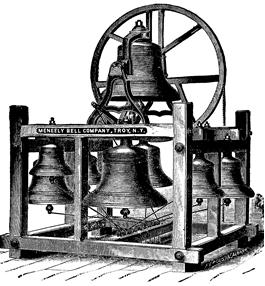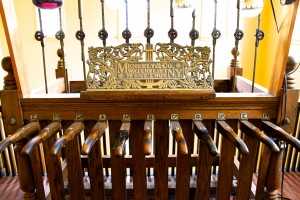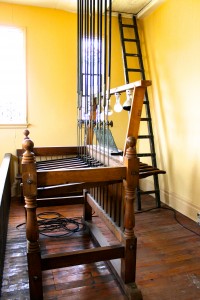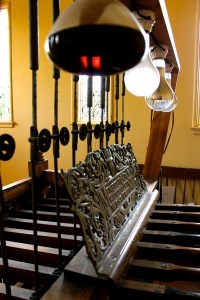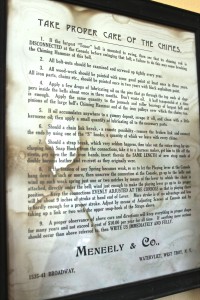The chime was presented to the town of Port Hope in 1912 by John Hume who requested that the chime be used for the delight and inspiration of the citizens in general, and that it be kept in the best possible state of repair. The chime was dedicated on Sunday, June 30, 1912.
The frame in which the chime is housed had to be constructed to suit the size and features of the tower and the illustration below shows how the chime is mounted on the frame.
Mrs. J.R. Waldie recalled the visit of her Majesty Queen Elizabeth II to Port Hope in 1959 on her greetings to St. Paul’s church on its 150th Anniversary. As the Queen’s motorcade passed St. Paul’s Church “God Save the Queen” was played on the Church chime. Prince Phillip looked up to the tower and turned to the Queen with a smile on his face indicating a feeling of joy at a thoughtful welcome.
The chiming console illustrated below has eleven levers, corresponding to and named as the bells. The Chime consists of one huge tolling bell and 11 bells ranging from E to F#.
The method of playing is more or less a vigorous stroke, not a mere push, grasping the lever end firmly with the hand. The note then sounds out clear and rich from the belfry with the same prompt response as from a piano. After some practice the knack is easily acquired and become a pleasurable exercise.
The chimes were made and installed by The Meneely Bell Foundry established in 1826 in West Troy (now Watervliet) , New York,by Andrew Meneely, a former apprentice in the foundry of Benjamine Hanks.Two of Andrew’s sons continued to operate the foundry after his death, while a third son, Clinton H. Meneely, opened a second foundry across the river with George H. Kimberly in Troy, New York in 1870. Initially named the Meneely Bell Company of Troy, this second foundry was reorganized in 1880 as the Clinton H. Meneely Company, then again as the Meneely Bell Company. Together, the two foundries produced about 65,000 bells before they closed in 1952.
Their Website is: http:\\meneely.net
On the wall behind the chime console is a picture with detailed instructions on how to maintain the chimes
The poster above reads:
Take Proper Care of The Chimes.
- If the larges “Tenor” bell is mounted to swing, the see that its chiming rod is DISCONNECTED at the console before swinging that bell; a failure to do this may cause breaking the Chiming Hammer of this bell
- All bold-nuts should be examined and screwed up tightly ever every year.
- All wood-work should be painted with some good paint at least once in three years. All iron parts, chains etc., should be painted once it two years with black asphaltum paint.
- Apply a few drops of lubricating oil on the pins that go through the top ends of clappers inside the bells about once in three months. Don’t waste oil. A half teaspoonful at a time is enough. Apply the same quantity to the journals and roller bearings of largest bell and pinions of the large bell’s Chiming Hammer and of the iron pulleys over which over which the chains run.
- If oil accumulates anywhere to a gummy deposit, scrap it off and clean with a little kerosene oil; then apply a small quantity of lubricating oil to the necessary parts.
- Should a chain link break, – a remote possibility – remove the broken link and connect the ends by using one of the “S” hooks, a quantity of which we leave with every chime.
- Should a strap break, which very seldom happens, then take out the entire strap by unclasping both Snap Hooks from the connections, take it to a harness maker, get him to file off the rivets, pry open the flat iron bands, insert therein the SAME LENGTH of the new strap made of double harness leather and re-rivet as they originally were.
- If the tension of any Spring becomes weak, so as to let the Playing lever at the Console hand down an inch or more, the unscrew the connection at the Console, go up to the bells and hang down an inch or more, then unscrew the connection at the Console, go up to the bells and wind up such weak spring just one of two notches by means of the lever to which the chain is

